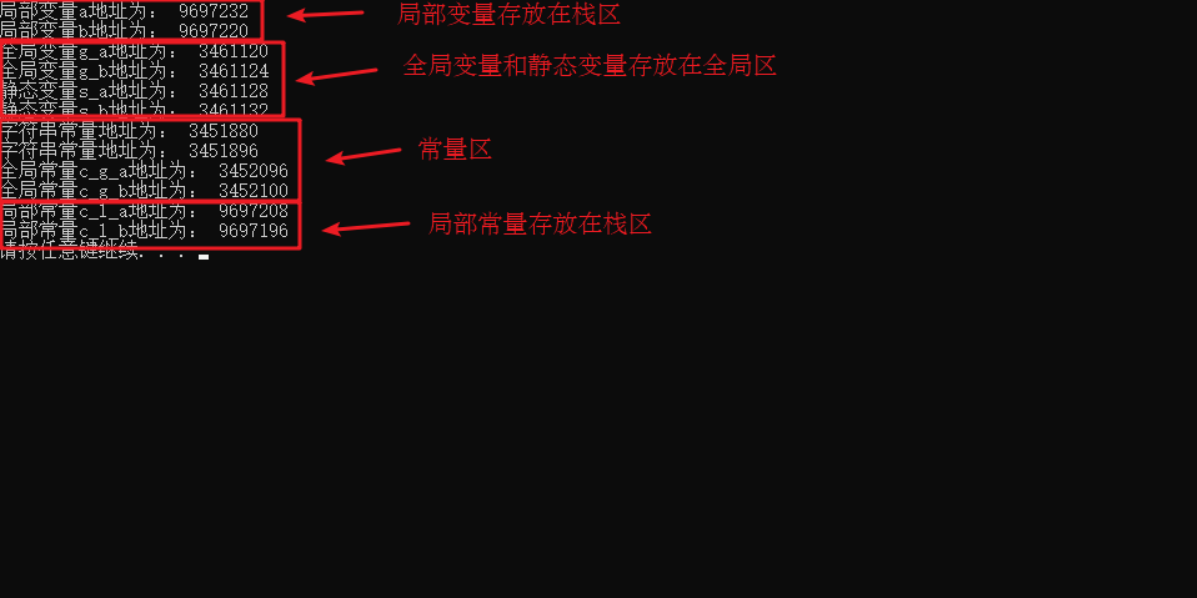分区模型
C++程序在执行时,将内存大方向划分为4个区域
- 代码区:存放函数体的二进制代码,由操作系统进行管理的
- 全局区:存放全局变量和静态变量以及常量
- 栈区:由编译器自动分配释放, 存放函数的参数值,局部变量等
- 堆区:由程序员分配和释放,若程序员不释放,程序结束时由操作系统回收
内存四区意义:
不同区域存放的数据,赋予不同的生命周期, 给我们更大的灵活编程
程序运行前
在程序编译后,生成了exe可执行程序,未执行该程序前分为两个区域
代码区:
存放 CPU 执行的机器指令
代码区是共享的,共享的目的是对于频繁被执行的程序,只需要在内存中有一份代码即可
代码区是只读的,使其只读的原因是防止程序意外地修改了它的指令
全局区:
全局变量和静态变量(static)存放在此.
全局区还包含了常量区, 字符串常量和其他常量(不包括局部常量)也存放在此.
该区域的数据在程序结束后由操作系统释放
//全局变量
int g_a = 10;
int g_b = 10;
//全局常量
const int c_g_a = 10;
const int c_g_b = 10;
int main() {
//局部变量
int a = 10;
int b = 10;
//打印地址
cout << "局部变量a地址为: " << (int)&a << endl;
cout << "局部变量b地址为: " << (int)&b << endl;
cout << "全局变量g_a地址为: " << (int)&g_a << endl;
cout << "全局变量g_b地址为: " << (int)&g_b << endl;
//静态变量
static int s_a = 10;
static int s_b = 10;
cout << "静态变量s_a地址为: " << (int)&s_a << endl;
cout << "静态变量s_b地址为: " << (int)&s_b << endl;
cout << "字符串常量地址为: " << (int)&"hello world" << endl;
cout << "字符串常量地址为: " << (int)&"hello world1" << endl;
cout << "全局常量c_g_a地址为: " << (int)&c_g_a << endl;
cout << "全局常量c_g_b地址为: " << (int)&c_g_b << endl;
const int c_l_a = 10;
const int c_l_b = 10;
cout << "局部常量c_l_a地址为: " << (int)&c_l_a << endl;
cout << "局部常量c_l_b地址为: " << (int)&c_l_b << endl;
system("pause");
return 0;
}

程序运行后
栈区:
由编译器自动分配释放, 存放函数的参数值,局部变量等
注意事项:不要返回局部变量的地址,栈区开辟的数据由编译器自动释放
#include<iostream>
using namespace std;
/*
局部变量保存在栈空间,栈空间的数据在函数执行完以后会自动释放
所以不要返回局部变量的地址
*/
int * func() {
int a = 10;
return &a;
}
int main() {
int * p = func();
cout << *p << endl; //10,是因为编译器做了保留
cout << *p << endl; //2031917448乱码
system("pause");
return 0;
}
堆区:
由程序员分配释放,若程序员不释放,程序结束时由操作系统回收
在C++中主要利用new在堆区开辟内存
new操作符
C++中利用new操作符在堆区开辟数据
堆区开辟的数据,由程序员手动开辟,手动释放,释放利用操作符 delete
语法: new 数据类型
利用new创建的数据,会返回该数据对应的类型的指针
在堆空间开辟空间
#include<iostream>
using namespace std;
/*
如果自己控制局部变量的销毁,那么使用new关键字
这样的话,即使函数已经执行完毕,也不会进行销毁
因为,new出来的数据是保存在堆空间
*/
int * func() {
int * p = new int(10);
return p;
}
int main() {
int * p = func();
cout << *p << endl; //10
cout << *p << endl; //10
system("pause");
return 0;
}
释放指定的空间
#include<iostream>
using namespace std;
int * func() {
int * p = new int(10);
return p;
}
int main() {
int * p = func();
cout << *p << endl; //10
delete(p); // 释放指针p指向的堆区空间
cout << *p << endl; //此时指针p指向的堆区空间已经释放,再次解引用会报错
system("pause");
return 0;
}